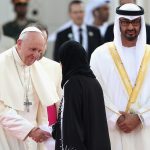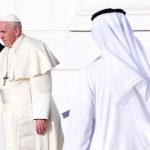Martin Mosebach opens up a world unknown to the West – a Church that has been a persecuted minority for over 1,000 years.
I have recently read The 21: A Journey in the Land of Coptic Martyrs by Martin Mosebach, an acclaimed German novelist, essayist and poet. He is a Catholic which makes sense when you read it; his reflections are too perceptive to have been written by someone without religious belief.
His book concerns an event that made worldwide news in February 2015, when 20 Coptic migrant workers from Egypt (the 21st, from Ghana, was “adopted” as a Copt when he chose to die with them) were beheaded on a Libyan beach on 15 February that year by black-clad, masked ISIS terrorists. It wasn’t possible to read the book quickly, or skip sections; this was partly out of respect for the story itself and partly because on nearly every page Mosebach has worthwhile things to say. This is not glib, dramatic or sensational journalism but a sober and insightful investigation into what lay behind the lives of these young men.
Mosebach is essentially asking the question we would all pose when confronting the fact of their martyrdom (it is reported that during their 43-day captivity before their executions they were offered the choice to live if they abjured their faith and embraced Islam but refused): what gave them the courage and the steadfastness to face their gruesome end with such patience and dignity, murmuring “O my Lord Jesus” as the knives were held to their throats?
All this has been captured on video, unedited and uncensored, made by the terrorists in order to inspire fear in those who watched it. That this purpose misfired spectacularly is evident in the behaviour of the martyrs. Mosebach is not interested in investigating ISIS. His purpose is to discover the power of the Coptic Church in the lives of its followers – a power he makes clear is not that of a death-embracing cult but that of a vibrant, joyful Church.
Indeed, reading this account gives the reader a glimpse of what it must have been like to be an early Christian during the persecutions in ancient Rome, singing hymns in the catacombs as they were led into the Colosseum. It seems the 21 young men sang and prayed during their captivity before their deaths; daily beatings and torture could not quell their ardent love for their faith. Reading of their individual character traits in the official martyrology read by Mosebach when he visited their families in the village of El-Aour in Upper Egypt in 2017, is to be confronted by a strange spiritual beauty: “He gave alms even though he was poor”; “He was a man of prayer and liturgy”; “He was quick to forgive, argued with no-one”; “He was an honest worker and treated his parents with respect” – and so on. The migrant workers were clearly men of great and humble virtue.
Some of them were married, with children; some were illiterate; all were poor, which is why they had gone to Libya as migrant workers and stayed on even when its low-level civil war made it extremely dangerous to do so. Mosebach (an advocate of the Tridentine rite of Mass) intriguingly describes the men as “homines liturgi” – “men of the liturgy.” The Coptic Church, traditionally thought to have been founded by St Mark in Egypt in the 1st century, is not in communion with Rome but its liturgy and hierarchy are venerable and ancient: Mass lasts for almost three hours with a continual sung liturgy. Some of the martyrs were in the church choir; all of them would have known the prayers of the liturgy by heart.
It is when Mosebach visited the village where many of the young men had come from that their heroic behaviour becomes (almost) explicable. The Copts describe themselves as “the Church of the Martyrs”, a constant succession down the centuries, into which the 21 find their own place; now venerated with crowns of martyrdom, their icons are everywhere. Whatever grief or sorrow their families must have felt, the author tells us that “the household was not in mourning.” The young widows left behind would not consider remarriage such was their reverence for the dead.
Again, Mosebach emphasises that “These were not Spartan mothers celebrating some rigid ideal, but rather believers whose faith had been forged and strengthened by adversity.” Later, interviewing the Coptic Metropolitan, the author records his impression of his “undisputed greatness” and of his “strength and power”. He drily wonders how Nietszche, who thought of Christianity as the religion of slaves, would “spare off against this particular priest.”
As a German Catholic, Mosebach is forced to make comparisons between the Western Church and this formidable Church which, since the Muslim invasion, has been in the minority in Egypt for over 1,400 years. He reflects that after Constantine, Christians “had to learn to withstand the temptations of pagan culture and engage in intellectual battle with it”. The implicit message is that in the West the pagan culture has won. We are reminded that the first hermits and monks, hermitages and monasteries were established in Egypt, in the desert, far from the cities.
Subsequently the Copts learned to cope with a long history of withstanding oppression and thus gain “an intimate knowledge of martyrdom.” Reading these pages opens up an unknown world; that of a Church, barely known in the West and as little understood. Mosebach’s final reflection is that we need to become better acquainted with it as western secular society becomes a more hostile environment to those still determined to bear witness to Christ.
________________
https://catholicherald.co.uk/commentandblogs/2019/02/05/what-gave-the-coptic-martyrs-such-steadfast-courage/?platform=hootsuite&fbclid=IwAR1NaECDWxrRXveJqoiYxKAyzqD8K19MCLSKiI5xfbzu05q6f03ckb9muDo





